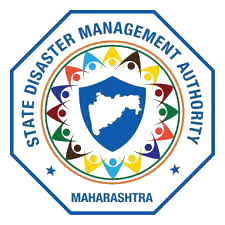FAQ’s
What is the Maharashtra State Disaster Management Authority (SDMA) and what does it do?
The Maharashtra State Disaster Management Authority (SDMA) is the apex statutory body constituted under the Disaster Management Act, 2005, to oversee all aspects of disaster management in the state. Chaired by the Hon’ble Chief Minister of Maharashtra, SDMA is responsible for laying down policies, approving plans, and coordinating efforts for disaster risk reduction, preparedness, mitigation, response, and recovery across the state.
Its functions include:
- Formulating the State Disaster Management Plan (SDMP) and ensuring its implementation.
- Coordinating with national bodies like the National Disaster Management
Authority (NDMA), IMD, NDRF, and other state departments. - Establishing and maintaining emergency infrastructure like the State Emergency Operations Centre (SEOC), District EOCs, and response mechanisms.
- Conducting hazard risk assessments and promoting mitigation efforts.
- Building community resilience through awareness, capacity building, and
volunteer programs such as Aapda Mitra.
The SDMA plays a critical role in ensuring that Maharashtra is prepared to handle awide range of natural and human-induced hazards.
What kinds of disasters are managed by SDMA Maharashtra?
SDMA Maharashtra is responsible for managing but not limited to notified disasters.
These include:
- Floods: Riverine floods, urban floods due to heavy rainfall or poor drainage systems.
- Landslides: Especially in hilly districts like Raigad, Ratnagiri, Sindhudurg, Satara, and Kolhapur.
- Earthquakes: Maharashtra falls in seismic zones III and IV, with vulnerability in regions like Latur and Koyna.
- Cyclones: Coastal districts such as Mumbai, Thane, Ratnagiri, and Sindhudurg face risks from Arabian Sea cyclones.
- Heatwaves: Especially in districts like Nagpur, Chandrapur, Akola, and Amravati.
- Lightning: Frequent in Vidarbha and Marathwada.
- Droughts: Common in rain-shadow areas such as Beed, Jalna, and Ahmednagar.
- Chemical spills, industrial fires, gas leaks (especially in MIDC areas).
- Building collapses, road/rail accidents, and urban fires.
- Biological hazards such as pandemics (e.g., COVID-19), zoonotic diseases, or food-borne outbreaks.
By coordinating preventive, preparatory, and responsive actions, SDMA ensures that the state is better equipped to deal with both predictable seasonal disasters and sudden-onset events.
How can I contact SDMA or get help during an emergency?
In the event of a disaster or emergency, citizens of Maharashtra have several channels to seek immediate help and information:
- Universal Emergency Helpline – 112
- District Emergency Operation Centers (DEOCs) — 1070
- State Emergency Operations Centre (SEOC): 11077/ +91-9321587143
- Social Media Helpline:
This is India’s integrated emergency number which connects you to police, fire, and medical services.
Every district in Maharashtra has a dedicated DEOC, which acts as a local command and control hub during disasters. You can contact your District Collector’s Office or visit the DEOC directly.
Located in Mumbai, the SEOC operates 24×7 and coordinates with all DEOCs. You can reach out through the SDMA website or by emailing the Revenue & Disaster Management Department.
During emergencies, verified updates and instructions are shared on SDMA’s official Twitter/X (@SDMAMaharashtra), Instagram, Facebook, and LinkedIn pages.We urge citizens to keep emergency contact numbers handy and follow only official channels for verified information during disasters.


